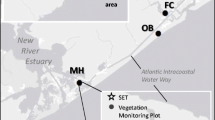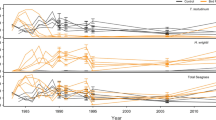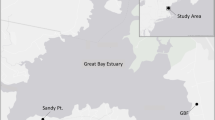Abstract
We report the results of a 5-year fertilization experiment in a central Long Island Sound salt marsh, aimed at understanding the impacts of high nutrient loads on marsh elevational processes. Fertilization with nitrogen led to some significant changes in marsh processes, specifically increases in aboveground primary production and in CO2 fluxes from the soil. However, neither nitrogen nor phosphorus fertilization led to elevation loss (relative to controls), reduced soil carbon, or a decrease in belowground primary production, all of which have been proposed as links between elevated nutrient loads and marsh drowning. Our data suggest that high nutrient levels increase gross carbon loss from the sediment, but that this is compensated for by other processes, leading to no net deleterious effect of nutrient loading on carbon storage or on marsh stability with respect to sea level rise.



Similar content being viewed by others
References
Alber, M., E.M. Swenson, S.C. Adamowicz, and I.A. Mendelssohn. 2008. Salt Marsh Dieback: an overview of recent events in the US. Estuarine Coastal and Shelf Science 80: 1–11.
Anisfeld, S.C., M.J. Tobin, and G. Benoit. 1999. Sedimentation rates in flow-restricted and restored salt marshes in Long Island Sound. Estuaries 22: 231–244.
Bertness, M.D., and B.R. Silliman. 2008. Consumer control of salt marshes driven by human disturbance. Conservation Biology 22: 618–623.
Bertness, M.D., C. Crain, C. Holdredge, and N. Sala. 2008. Eutrophication and consumer control of New England salt marsh primary productivity. Conservation Biology 22: 131–139.
Bowen, J.L., B.C. Crump, L.A. Deegan, and J.E. Hobbie. 2009. Increased supply of ambient nitrogen has minimal effect on salt marsh bacterial production. Limnology and Oceanography 54: 713–722.
Cahoon, D.R., and R.E. Turner. 1989. Accretion and canal impacts in a rapidly subsiding wetland II: Feldspar marker horizon technique. Estuaries 12: 260–268.
Cahoon, D.R., D.J. Reed, and J.W. Day. 1995. Estimating shallow subsidence in microtidal salt marshes of the southeastern United States—Kaye and Barghoorn revisited. Marine Geology 128: 1–9.
Cahoon, D.R., J.C. Lynch, and R.M. Knaus. 1996. Improved cryogenic coring device for sampling wetland soils. Journal of Sedimentary Research 66: 1025–1027.
Cahoon, D.R., J.C. Lynch, B.C. Perez, B. Segura, R.D. Holland, C. Stelly, G. Stephenson, and P. Hensel. 2002. High-precision measurements of wetland sediment elevation: II. The rod surface elevation table. Journal of Sedimentary Research 72: 734–739.
Dai, T., and R.G. Wiegert. 1996. Estimation of the primary productivity of Spartina alterniflora using a canopy model. Ecography 19: 410–423.
Darby, F.A., and R.E. Turner. 2008a. Below- and aboveground biomass of Spartina alterniflora: Response to nutrient addition in a Louisiana salt marsh. Estuaries and Coasts 31: 326–334.
Darby, F.A., and R.E. Turner. 2008b. Effects of eutrophication on salt marsh root and rhizome biomass accumulation. Marine Ecology-Progress Series 363: 63–70.
Day, J.W., G.P. Shaffer, L.D. Britsch, D.J. Reed, S.R. Hawes, and D. Cahoon. 2000. Pattern and process of land loss in the Mississippi Delta: a spatial and temporal analysis of wetland habitat change. Estuaries 23: 425–438.
Delaune, R.D., R.H. Baumann, and J.G. Gosselink. 1983. Relationships among vertical accretion, coastal submergence and erosion in a Louisiana Gulf Coast marsh. Journal of Sedimentary Petrology 53: 147–157.
DeLaune, R.D., J.A. Nyman, and W.H. Patrick Jr. 1994. Peat collapse, ponding and wetland loss in a rapidly submerging coastal marsh. Journal of Coastal Research 10: 1021–1030.
Hartig, E.K., V. Gornitz, A. Kolker, F. Mushacke, and D. Fallon. 2002. Anthropogenic and climate-change impacts on salt marshes of Jamaica Bay, New York City. Wetlands 22: 71–89.
Holdredge, C., M.D. Bertness, and A.H. Altieri. 2009. Role of crab herbivory in die-off of New England salt marshes. Conservation Biology 23: 672–679.
Howes, B.L., J.W.H. Dacey, and J.M. Teal. 1985. Annual carbon mineralization and belowground production of Spartina alterniflora in a New England salt marsh. Ecology 66: 595–605.
Hughes, R.G., and O.A.L. Paramor. 2004. On the loss of saltmarshes in south-east England and methods for their restoration. Journal of Applied Ecology 41: 440–448.
Kearney, M.S., A.S. Rogers, J.R.G. Townshend, D. Stutzer, J.C. Stevenson, and K. Sundborg. 2002. Landsat imagery shows decline of coastal marshes in Chesapeake and Delaware Bays. Eos 83: 175–178.
Kirwan, M.L., and A.B. Murray. 2008. Tidal marshes as disequilibrium landscapes? Lags between morphology and Holocene sea level change. Geophysical Research Letters 35: 5.
Kirwan, M., and S. Temmerman. 2009. Coastal marsh response to historical and future sea-level acceleration. Quaternary Science Reviews 28: 1801–1808.
Kirwan, M.L., A.B. Murray, and W.S. Boyd. 2008. Temporary vegetation disturbance as an explanation for permanent loss of tidal wetlands. Geophysical Research Letters 35: L05403.
Kirwan, M.L., A.B. Murray, J.P. Donnelly, and D.R. Corbett. 2011. Rapid wetland expansion during European settlement and its implication for marsh survival under modern sediment delivery rates. Geology 39: 507–510. doi:10.1130/g31789.1.
Kolker, A.S., S.L. Goodbred, S. Hameed, and J.K. Cochran. 2009. High-resolution records of the response of coastal wetland systems to long-term and short-term sea-level variability. Estuarine Coastal and Shelf Science 84: 493–508.
Langley, J.A., K.L. McKee, D.R. Cahoon, J.A. Cherry, and J.P. Megonigal. 2009. Elevated CO2 stimulates marsh elevation gain, counterbalancing sea-level rise. Proceedings of the National Academy of Sciences of the United States of America 106: 6182–6186.
Levine, J.M., J.S. Brewer, and M.D. Bertness. 1998. Nutrients, competition and plant zonation in a New England salt marsh. Journal of Ecology 86: 285–292.
McFarlin, C.R., J.S. Brewer, T.L. Buck, and S.C. Pennings. 2008. Impact of fertilization on a salt marsh food web in Georgia. Estuaries and Coasts 31: 313–325.
McKee, K.L., D.R. Cahoon, and I.C. Feller. 2007. Caribbean mangroves adjust to rising sea level through biotic controls on change in soil elevation. Global Ecology and Biogeography 16: 545–556.
Moffett, K.B., A. Wolf, J.A. Berry, and S.M. Gorelick. 2010. Salt marsh–atmosphere exchange of energy, water vapor, and carbon dioxide: Effects of tidal flooding and biophysical controls. Water Resources Research 46: 18.
Morris, J.T. 1991. Effects of nitrogen loading on wetland ecosystems with particular reference to atmospheric deposition. Annual Review of Ecology and Systematics 22: 257–279.
Morris, J.T., and P.M. Bradley. 1999. Effects of nutrient loading on the carbon balance of coastal wetland sediments. Limnology and Oceanography 44: 699–702.
Morris, J.T., P.V. Sundareshwar, C.T. Nietch, B. Kjerfve, and D.R. Cahoon. 2002. Responses of coastal wetlands to rising sea level. Ecology 83: 2869–2877.
Morris, J.T., K. Sundberg, and W. Hankinson. 2010a. Annual productivity at Spartina alterniflora-dominated salt marsh plots in North Inlet, Georgetown, SC. Online LTER dataset. http://ecosystems.mbl.edu/pie/data/lte/LTE-MP-NIN-productivity.html.
Morris, J.T., K. Sundberg, R. Daoust, H. Marshall, and D. Rodriguez. 2010b. Annual Primary Productivity of Spartina alterniflora at Law’s Point salt marsh on the Rowley River. Online LTER dataset. http://ecosystems.mbl.edu/PIE/data/LTE/LTE-MP-LPA-productivity.html.
NYSDEC/CTDEP. 2000. A total maximum daily load analysis to achieve water quality standards for dissolved oxygen in Long Island Sound. Albany/Hartford: NYS Department of Environmental Conservation/CT Department of Environmental Protection
Orson, R.A., R.S. Warren, and W.A. Niering. 1998. Interpreting sea level rise and rates of vertical marsh accretion in a southern New England tidal salt marsh. Estuarine Coastal and Shelf Science 47: 419–429.
Paquette, C.H., K.L. Sundberg, R.M.J. Boumans, and G.L. Chmura. 2004. Changes in saltmarsh surface elevation due to variability in evapotranspiration and tidal flooding. Estuaries 27: 82–89.
R Development Core Team. 2010. R: A language and environment for statistical computing. Vienna: R Foundation for Statistical Computing.
Rybczyk, J.M., and D.R. Cahoon. 2002. Estimating the potential for submergence for two wetlands in the Mississippi River Delta. Estuaries 25: 985–998.
Smart, R.M., and J.W. Barko. 1980. Nitrogen nutrition and salinity tolerance of Distichlis Spicata and Spartina Alterniflora. Ecology 61: 630–663.
Smith, S.M. 2009. Multi-decadal changes in salt marshes of Cape Cod, MA: photographic analyses of vegetation loss, species shifts, and geomorphic change. Northeastern Naturalist 16: 183–208.
Stevenson, J.C., M.S. Kearney, and E.W. Koch. 2002. Impacts of sea level rise on tidal wetlands and shallow water habitats: a case study from Chesapeake Bay. Fisheries in a Changing Climate 32: 23–36.
Sullivan, M.J., and F.C. Daiber. 1974. Response in production of cordgrass Spartina alterniflora to inorganic nitrogen and phosphorus fertilizer. Chesapeake Science 15: 121–123.
Sundareshwar, P.V., J.T. Morris, E.K. Koepfler, and B. Fornwalt. 2003. Phosphorus limitation of coastal ecosystem processes. Science 299: 563–565.
Swanson, R.L., and R.E. Wilson. 2008. Increased tidal ranges coinciding with Jamaica Bay development contribute to marsh flooding. Journal of Coastal Research 24: 1565–1569.
Tiner, R.W., I.J. Huber, T. Nuerminger, and E. Marshall. 2006. Salt marsh trends in selected estuaries of Southwestern Connecticut. Hadley: US Fish and Wildlife Service.
Turner, R. 2010. Beneath the Salt Marsh Canopy: Loss of soil strength with increasing nutrient loads. Estuaries and Coasts. doi:10.1007/s12237-010-9341-y.
Turner, R.E., E.M. Swenson, C.S. Milan, J.M. Lee, and T.A. Oswald. 2004. Below-ground biomass in healthy and impaired salt marshes. Ecological Research 19: 29–35.
Turner, R.E., B.L. Howes, J.M. Teal, C.S. Milan, E.M. Swenson, and D.D. Goehringer-Toner. 2009. Salt marshes and eutrophication: An unsustainable outcome. Limnology and Oceanography 54: 1634–1642.
Valiela, I., and J.M. Teal. 1974. Nutrient limitation in salt marsh vegetation. In Ecology of Halophytes, ed. R.J. Reimold and W.H. Queen, 547–563. New York: Academic Press.
Valiela, I., J.M. Teal, and N.Y. Persson. 1976. Production and dynamics of experimentally enriched salt marsh vegetation: Belowground biomass. Limnology and Oceanography 21: 245–252.
Wigand, C., P. Brennan, M. Stolt, M. Holt, and S. Ryba. 2009. Soil respiration rates in coastal marshes subject to increasing watershed nitrogen loads in southern New England, USA. Wetlands 29: 952–963.
Wolters, M., J.P. Bakker, M.D. Bertness, R.L. Jefferies, and I. Moller. 2005. Saltmarsh erosion and restoration in south-east England: Squeezing the evidence requires realignment. Journal of Applied Ecology 42: 844–851.
Acknowledgments
This research was funded by the Environmental Protection Agency (grant LI-97100801), with additional support from the Connecticut Sea Grant program (through the Yale Center for Coastal and Watershed Studies), a Carpenter-Sperry Environmental Research Grant, and a Sounds Conservancy grant from the Quebec-Labrador Foundation. We thank the Jaeger and Reed families for their generous permission to carry out this research on their property. The manuscript benefited from comments from two anonymous reviewers. Don Cahoon of the US Geological Survey provided valuable guidance and support on experimental design and SET use, along with helpful comments on the manuscript. Our research benefited from helpful conversations with Scott Warren and Ron Rozsa. Jim Lynch of the US Geological Survey assisted greatly in SET installation and training. Philippe Hensel of the National Oceanographic and Atmospheric Administration provided advice on statistical analysis of SET data. Jim Morris and Karen Sundberg of the University of South Carolina provided advice on field techniques. Jim Morris and the Plum Island Ecosystems Long Term Ecological Research (LTER) site allowed access to unpublished productivity data from the LTER database. Harry Yamalis and Kristen Bellantuono of the Connecticut Department of Environmental Protection expedited the process of obtaining permits. Many students assisted with field and lab work, including: Joanna Carey, Janny Choy, Jessica Darling, Kevin Lauterbach, Manuel Mavila, Azalea Mitch, Sally Nunnally, Tina O’Connell, Nadav Tanners, Matthew Chmielewski, and Kate Woodruff. Lab supervision and training were provided by Jonas Karosas and Helmut Ernstberger.
Author information
Authors and Affiliations
Corresponding author
Rights and permissions
About this article
Cite this article
Anisfeld, S.C., Hill, T.D. Fertilization Effects on Elevation Change and Belowground Carbon Balance in a Long Island Sound Tidal Marsh. Estuaries and Coasts 35, 201–211 (2012). https://doi.org/10.1007/s12237-011-9440-4
Received:
Revised:
Accepted:
Published:
Issue Date:
DOI: https://doi.org/10.1007/s12237-011-9440-4




